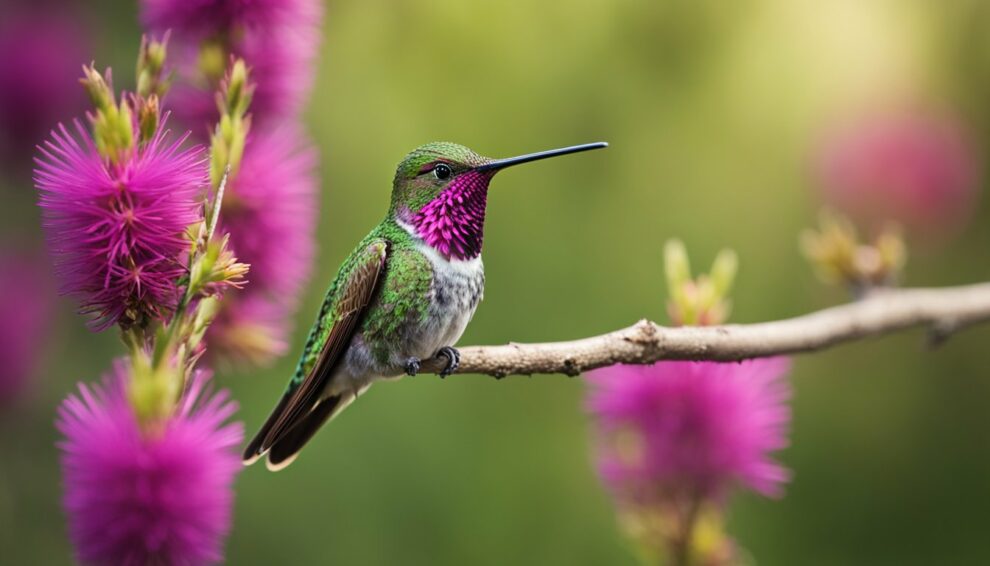Imagine looking at a bird that seems like it’s dressed in a coat of green feathers, but suddenly, with a swift turn of its head, it dazzles you with a radiant splash of red.
This is the magic of the Anna’s hummingbird, a tiny avian acrobat whose feathers possess an extraordinary ability to change color.
The feathers themselves don’t undergo any pigmentation transformation; instead, it’s the structure of the feathers that plays with light to create this mesmerizing effect.

The Anna’s hummingbird, not much larger than a lively acorn, commands attention with more than just its dynamic color display; its courtship dives and energetic flight are just as captivating.
The secret behind its changing colors lies in something called iridescence – it’s similar to the glimmering colors you’d see in a soap bubble or in a drop of oil on water.
Tiny microscopic structures in the feathers reflect sunlight in such a way that the colors shift and shimmer as the angle of light changes.
Just think, what color will the Anna’s hummingbird show next as it dances in the air?
Now, if you ever spot an Anna’s hummingbird zipping through the air, notice how its feathers might glisten with a green glow one moment and flare into a brilliant rosy hue the next.
They’re like tiny jewels of nature, adding a flash of color to the world, one wingbeat at a time.
Isn’t it incredible how a creature so small can hold such a big secret in its feathers?
What colors will you see when you next encounter this winged wonder?
The Science Behind the Sparkle

The shimmer and glimmer of the Anna’s Hummingbird’s feathers are not just a simple trick of pigmentation, but a complex interplay of light and the bird’s unique feather structure that results in the dazzling display of colors.
The Role of Light and Structure
When sunlight hits the feathers of the Anna’s Hummingbird, something magical happens.
Unlike colors formed by pigments, the iridescent sparkle of these birds is produced by structural coloration.
This is largely due to the microscopic structure of the feathers’ barbules, where light is reflected and refracted.
Imagine light entering a prism and coming out as a spectrum of colors—that’s a little like what happens with these feathers.
Their feathers contain layers of keratin and air pockets, which interfere with the light, splitting it into various colors depending on the viewer’s angle of sight.
These colors are not created by the light itself, but by the way it interacts with the structures on the feather.
With a twist of their head or a change in position, the Anna’s Hummingbird can make their feathers flash bright colors like a disco ball.
It’s this structure that works in tandem with light to give the illusion of changing colors.
Pigments and the Color Palette
Now, one might wonder if structural coloration is the only player in the color game. Not quite. Pigments have a role too.
Melanin, the same pigment that adds color to human skin and hair, is present in the feathers of the Anna’s Hummingbird, but it serves a different purpose.
It provides a dark background that enhances the bright iridescence of the feathers.
Iridescence is this delightful play of lustrous colors that seem to shift when seen from different angles.
What’s particularly striking about the hummingbird’s feathers is how the melanin is packed into structures known as melanosomes.
The shape and arrangement of these melanosomes create a surface that reflects light in such a way that only certain colors are seen at certain angles, contributing to the feather’s overall iridescent quality.
By examining the relationship between light, structural coloration, and pigmentation, one can appreciate the elaborate design that nature has crafted, enabling these birds to sport such a vibrant wardrobe.
This combination of factors ultimately culminates in the breathtaking spectacle of the Anna’s Hummingbird’s colors.
Isn’t it incredible how something as simple as a feather and light can create such a visual feast?
A Symphony of Colors
The Anna’s Hummingbird is a living prism, revealing a world of colors invisible to the human eye.
As light dances off their feathers, these tiny birds display an ever-changing palette of color caught in motion.
Interplay of Colors in Males and Females
Males show off dazzling reds and vibrant greens that change with their movements.
Females, while generally more subdued, display their own unique iridescence with shimmering touches of greens and blues that blend into their surroundings.
While both sexes boast feathers that capture and refract light, the males use their bright throat patches, called gorgets, to impress and attract mates.
These throat feathers can appear almost like liquid metal—deep, glossy and dynamic.
Shifting Hues with Age and Angle
As these birds age, their coloration deepens, becoming more intense and refined.
The angle of light is a masterful artist at play on the canvas of their feathers, shaping how these colors are perceived.
When the sun hits just right, the ordinary greens burst into an assortment of colors as if they’re wearing a coat of many colors that flashes reds and blues.
Just by tilting their heads or fluttering from flower to flower, they transform the light into a wheel of rich hues, a visual treat for any observer lucky enough to catch a glimpse.
A young reader might wonder: why do they look like they’ve dipped their feathers in a paint pot?
It’s all how the light interacts with the microscopic structure of their feathers—something that becomes even more remarkable as they grow.
These are the secret tricks of nature, creating a spectacle of colors that brighten up the world of the Anna’s Hummingbird.
Patterns and Displays in Nature

The kaleidoscope of colors we find in a hummingbird’s feathers serves more purposes than mere beauty.
It’s a vital part of their survival, especially when it comes to impressing a potential mate and ensuring their lineage.
Courtship: A Dazzling Dance
When it’s time to woo, male Anna’s Hummingbirds take to the sky with a remarkable performance.
They climb up to great heights, showing off their shimmering feathers to the females below.
As sunlight catches their feathers, these little birds transform before our eyes, their green plumage bursting into iridescent reds and pinks that capture the attention of their audience.
This spectacular flight is not just for show; it’s a rigorous test to prove their strength and agility, qualities that female hummingbirds find irresistible.
Imagine being a female hummingbird watching this display; it’s a visual symphony that tells you all you need to know about the performer’s vigor.
Evolving Beauty: The Why and How
Beauty in birds, especially in hummingbirds, isn’t just a random occurrence.
It’s the result of a process called sexual selection, where traits that are attractive to potential mates become more common over generations.
This has led to a wide diversity among bird species, each with their unique patterns and displays.
The glinting feathers of the Anna’s Hummingbird, for instance, are not painted on.
Rather, they’re constructed of microscopic structures that bend light, creating those intense flashes of color that are so important during courtship rituals.
It’s as if they were wearing little prisms around their necks.
Can you picture the tiny feathers changing color like magic as the bird moves?
These feathered acrobats have evolved to dance under the spotlight of the sun, giving them the best chance to continue their species.
And so, the loop of beauty and evolution spins on.
Frequently Asked Questions

The changeable and shimmering colors of Anna’s hummingbird feathers are a true spectacle.
This section addresses the most commonly asked questions, shedding light on the remarkable aspects of Anna’s hummingbird’s plumage.
How do Anna’s Hummingbird feathers change color?
The feathers of an Anna’s Hummingbird can appear to change color in different lighting conditions.
This chameleon-like effect happens due to the light reflecting off the unique microscopic structure of their feathers, particularly those around the throat and head, which can shift from a dusky hue to brilliant reds and pinks.
What causes the iridescence in hummingbird feathers?
Iridescence in hummingbird feathers is the result of light waves interfering with each other as they bounce off the microscopic structures in the feathers.
This delicate and precise architecture splits light, producing the radiant glowing colors that seem to shift as the angle of light or the perspective of the viewer changes.
Can female hummingbirds also have color-changing feathers?
While female Anna’s Hummingbirds are less colorful than males, exhibiting more subdued greens and grays, they can have iridescent feathers too.
Some females display spots of red on their throats that can shimmer in the sunlight, although these features are less pronounced compared to the male’s brilliant displays.
How are a hummingbird’s feathers different from other birds?
Anna’s Hummingbird feathers differ from other birds firstly in their structure, enabling the distinct iridescent effect.
Unlike other birds that get color from pigments, the hummingbird’s coloration mostly comes from refracted light, giving them that trademark sparkle and sheen.
Are the colorful feathers of hummingbirds used for anything special?
Yes, indeed! The colorful feathers of hummingbirds play a vital role in courtship and territorial displays.
Male Anna’s Hummingbirds sport their vivid feathers to attract females and intimidate rivals, often engaging in impressive aerial maneuvers to show off their radiant plumage.
Is it possible to find hummingbird feathers in nature, and is it legal to collect them?
One may occasionally find a stray hummingbird feather on a walk, but it’s important not to collect them.
In many places, including the United States, it’s illegal to possess hummingbird feathers due to protective laws, such as the Migratory Bird Treaty Act, aimed at preserving these precious creatures.









